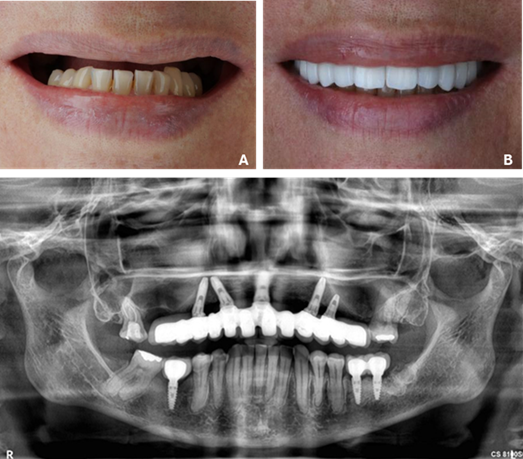Reabilitação com Cinco Implantes Osseointegrados em Maxila Atrófica: Relato de Caso
Conteúdo do artigo principal
Resumo
A perda dentária é um problema de saúde pública no Brasil, afetando a nutrição, fonação, estética e autoestima. As próteses suportadas por implantes são consideradas o padrão ouro para a substituição dos dentes perdidos. A reabsorção óssea, consequência da perda dentária, pode resultar em um rebordo atrófico, dificultando o tratamento com implantes. Este trabalho relata um caso de reabilitação com prótese total fixa suportada por cinco implantes em uma maxila atrófica. A paciente procurou o Instituto RC de Pós-graduação em Odontologia para substituir sua prótese removível maxilar por uma fixa, suportada por implantes. Após análise de exames de imagem, foi constatada uma maxila atrófica, com espessura óssea reduzida e pouca altura na região posterior devido à pneumatização do seio maxilar. A cirurgia para instalação de cinco implantes foi realizada, com distribuição e angulação adequadas. Três meses após a cirurgia, com os implantes osseointegrados, iniciou-se a fase protética e o tratamento foi finalizado com a instalação de um protocolo em porcelana. O uso de implantes angulados se mostrou uma excelente alternativa, permitindo o emprego de implantes longos, reduzindo o tamanho do cantilever distal e evitando procedimentos invasivos. Isso resultou em menor morbidade, tempo de tratamento reduzido e custos mais baixos.
Detalhes do artigo

Este trabalho está licenciado sob uma licença Creative Commons Attribution 4.0 International License.
Authors retain the copyright of their articles and grant the journal the right of first publication under the Creative Commons Attribution (CC BY) license, which allows others to share and adapt the work with proper attribution.
Referências
Silva ET, Oliveira RT, Leles CR. Fatores associados ao edentulismo funcional em idosos brasileiros. Comun Ciênc Saúde. 2016;27(2):129-138.
Cardoso M, et al. Edentulism in Brazil: trends, projections and expectations until 2040. Cien Saude Colet. 2016;21(4):1239-1245.
Rocha SS, et al. Próteses Totais Fixas Tipo Protocolo Bimaxilares: relato de caso. Rev Odontol Bras Central. 2013;21(60):21-27.
Cunha G, et al. Atrophic maxilla reconstruction with autogenous iliac graft and guided dental implants. J Craniofac Surg. 2018 Nov;29(8):2218-2219.
Sierra-Sanchez J, et al. Predictability of short implants (<10 mm) as a treatment option for the rehabilitation of atrophic maxilla: a systematic review. Med Oral Patol Oral Cir Bucal. 2016;21(3):e392-e402.
Mittal Y, Jindal G, Garg S. Bone manipulation procedures in dental implants. Indian J Dent. 2016;7(2):86-94.
Agliardi EL, et al. Immediate full-arch rehabilitation of the severely atrophic maxilla supported by zygomatic implants: a prospective clinical study with minimum follow-up of 6 years. Int J Oral Maxillofac Surg. 2017;46(12):1592-1599.
Spencer KR. Implant-based rehabilitation options for the atrophic edentulous jaw. Aust Dent J. 2018;63(1):100-107.
Misch CM. Maxillary autogenous bone grafting. Oral Maxillofac Surg Clin North Am. 2011;23(2):229-238.
Peñarrocha-Oltra D, et al. Rehabilitation of the atrophic maxilla with tilted implants: review of the literature. J Oral Implantol. 2013;39(5):625-632.
Zanettini LMS, et al. Use of recombinant human bone morphogenetic protein-2 associated with lyophilized bovine bone in reconstruction of atrophic maxilla. J Craniofac Surg. 2018;29(7):1934-1938.
Durkan R, Oyar P, Deste G. Maxillary and mandibular all-on-four implant designs: a review. Niger J Clin Pract. 2019;22:1033-1040.
Corbella S, Taschieri S, Del Fabbro M. Long-term outcomes for the treatment of atrophic posterior maxilla: a systematic review of literature. Clin Implant Dent Relat Res. 2013;17(1):12-132.
Monje A, et al. Influence of atrophic posterior maxilla ridge height on bone density and microarchitecture. Clin Implant Dent Relat Res. 2013;17(1):111-119.
Mertens C, et al. Reconstruction of the severely atrophic edentulous maxillae with calvarial bone grafts. Clin Oral Implants Res. 2016;28(6):749-756.
Sayed S, Hassan M, Emarah M. All-on-4 versus all-on-6 implant concepts for rehabilitation of edentulous maxilla: short-term randomized clinical and radiographic study. Egypt Dent J. 2020;66:659-670.
Chaware SH, et al. The rehabilitation of posterior atrophic maxilla by using the graftless option of short implant versus conventional long implant with sinus graft: a systematic review and meta-analysis of randomized controlled clinical trial. J Indian Prosthodont Soc. 2021;21:28-44.
Esposito M, et al. Immediately loaded zygomatic implant vs. conventional dental implant in augmented atrophic maxilla: 4 months post loading result from multicentre randomized controlled trial. Eur J Oral Implantol. 2018;11:11-28.
Kern JS, et al. A systematic review and meta-analysis of removable and fixed implant-supported prostheses in edentulous jaws: post-loading implant loss. Clin Oral Implants Res. 2015;:1-22.
Misch CM. Maxillary autogenous bone grafting. Oral Maxillofac Surg Clin North Am. 2011;23(2):229-238.
Rocha SS, et al. Próteses Totais Fixas Tipo Protocolo Bimaxilares: relato de caso. Rev Odontol Bras Central. 2013;21(60):21-27.
Mertens C, et al. Reconstruction of the severely atrophic edentulous maxillae with calvarial bone grafts. Clin Oral Implants Res. 2016;28(6):749-756.
Mehta SP, et al. Clinical success between tilted and axial implants in edentulous maxilla: a systematic review and me-ta-analysis. J Indian Prosthodont Soc. 2021;21:217-228.
Maló P, et al. All-on-4® treatment concept for the rehabilitation of the completely edentulous mandible: a 7-year clinical and 5-year radiographic retrospective case series with risk assessment for implant failure and marginal bone level. Clin Implant Dent Relat Res. 2014;17:531-541.
Zincir OO, Parlar A. Comparison of stresses in monoblock tilted implants and conventional angled multiunit abut-ment-implant connection systems in the all-on-four procedure. BMC Oral Health. 2021;21(646):1-13.
Asawa N, et al. Angulated implants: an alternative to bone augmentation and sinus lift procedure: systematic review. J Clin Diagn Res. 2015;9(3):10-13.
Tischler M, Patch C, Bidra AS. Rehabilitation of edentulous jaws with zirconia complete-arch fixed implant-supported prostheses: an up to 4-year retrospective clinical study. J Prosthet Dent. 2018;120(2):204-209.
Moraes MM, de Oliveira M, Silva J, et al. The role of urban green spaces in the context of the COVID-19 pandemic: a case study of the city of São Paulo, Brazil. Sustain Cities Soc. 2020;61:102338. doi:10.1016/j.scs.2020.102338.
Kondo Y, Sakai K, Minakuchi H, Horimai T, Kuboki T; JSOI Clinical Guideline Working Group collaborators. Im-plant-supported fixed prostheses with cantilever: a systematic review and meta-analysis. Int J Implant Dent. 2024;10:57. doi:10.1186/s40729-024-00573-8.
